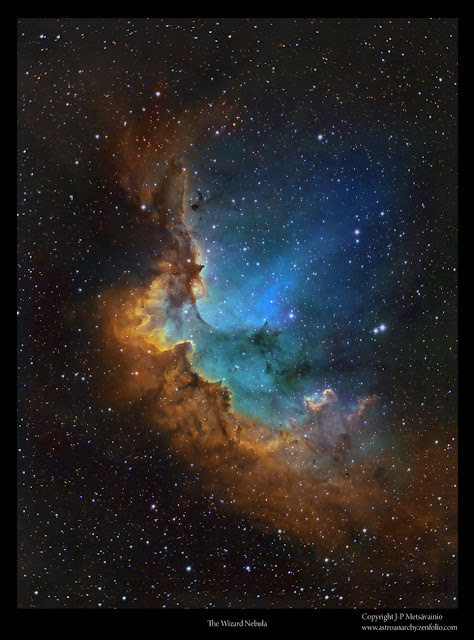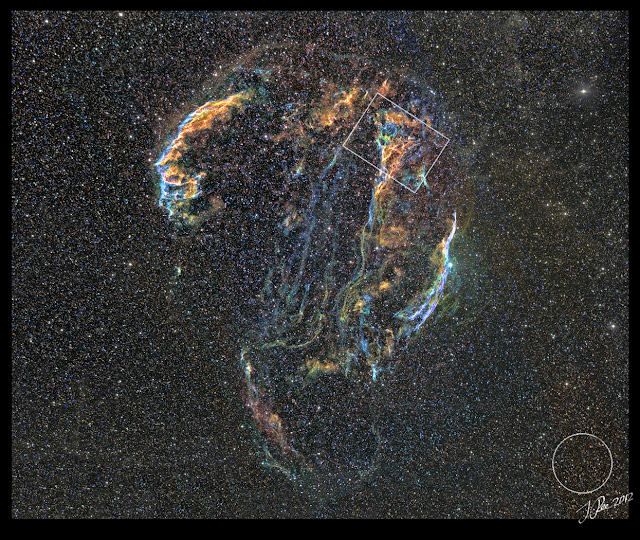COPYRIGHT, PLEASE NOTE
All the material on this website is copyrighted to J-P Metsavainio, if not otherwise stated. Any content on this website may not be reproduced without the author’s permission.
BUY A MUSEUM QUALITY POSTER
BUY A POSTER:https://astroanarchy.zenfolio.com/
Wednesday, May 22, 2013
Filaments of the Veil nebula, starless view
One of my starless astronomical image experiences, the Pickering's Triangle in Cygnus supernova remnant.
This area of the nebula is filled with colorful filaments, ionized sulfur and hydrogen are seen as green, golden hues, ionized oxygen can be seen as blue.
The complexity of filaments stands out nicely in this starless image.
An original image with the stars
Original blog post about this image, with the technical details, can be seen here:
http://astroanarchy.blogspot.fi/2012/11/pickerings-triangle-project-finalized.html
Orientation in the Veil Nebula SNR
INFO
Exposure and processing details
This area of the nebula is filled with colorful filaments, ionized sulfur and hydrogen are seen as green, golden hues, ionized oxygen can be seen as blue.
The Pickering's Triangle with a suppressed stars
A detail of the Veil Nebula supernova remnant
The complexity of filaments stands out nicely in this starless image.
An original image with the stars
Image is in mapped colors, from the emission of ionized elements, R=Sulfur, G=Hydrogen and B=Oxygen.
http://astroanarchy.blogspot.fi/2012/11/pickerings-triangle-project-finalized.html
Orientation in the Veil Nebula SNR
Area of interest is marked as a white rectangle, the apparent size of the Moon can be seen at lower right corner.
INFO
Pickering's Triangle, Simeis 3-188, is a small part of the Veil Nebula supernova remnant in constellation Cygnus.
Veil Nebula is a cloud of ionized gas and dust, leftovers from an exploded star. The star went off some 5000-8000 years ago at distance of about 1470 light years. This, relatively faint target, is difficult to image due to the large angular diameter, about three degrees, and a dense star field.
Exposure and processing details
Processing work flow:
Image acquisition, MaxiDL v5.07.
Stacked and calibrated in CCDStack2.
Levels, curves and color combine in PS CS3.
Optics, Meade LX200 GPS 12" @ f5
Camera, QHY9
Guiding, SXV-AO, an active optics unit, and Lodestar guide camera 8Hz
Image Scale, ~0,8 arc-seconds/pixel
15 x 1200s exposures for the H-alpha, emission of ionized Hydrogen = 5h
9 x 1200s exposures for the O-III, emission of ionized Oxygen = 3h
4x1200s exposures for the S-II, emission of ionized Sulfur = 1h 20min.
Labels:
Narrowband color images
Sunday, May 19, 2013
Never lose your sense of wonder!
Just a little reminder...
The Bubble Nebula
I shot this image of the Bubble Nebula back in 2009, large images and more info in this blog post:
http://astroanarchy.blogspot.fi/2011/03/bubble-nebula-reprocessed.html
Thursday, May 16, 2013
An experimental starless version of the Wizard nebula,
I like to make starless versions of my astronomical images now and then. They'll show the actual nebula better and have a kind of mystique feel.
Human brains has a tendency to form some quasi logical shapes out of cloud of random dots, like stars in this case. Without stars, the shapes in a gas cloud stands out much better.
A starless Sharpless 142 (Sh2-142), the Wizard Nebula
In constellation CepheusImage with a suppressed stars, click for a large image.
Original image with a technical details can be seen in THIS blog post.
Image with the stars

Info
NGC 7380 is a catalog number of the open star cluster inside Wizard nebula, SH2-142.
Nebula locates in constellation Cepheus, about 7000 light years from my home.
Technical details
Processing work flow:
Image acquisition, MaxiDL v5.07.
Stacked and calibrated in CCDStack.
Deconvolution with a CCDSharp, 30 iterations at 50% weight.
Levels, curves and color combine in PS CS3.
Telescope, Meade LX200 GPS 12" @ f5
Camera, QHY9 Guiding, SXV-AO @ 6,5Hz
Image Scale, 0,75 arcseconds/pixel
Exposures H-alpha 15x1200s, binned 1x1
S-II 1x1200s, binned 4x4
O-III 1x1200s, binned 4x4
Beside data here, a color information from an older wide field image is used.
Image can be seen here: http://astroanarchy.blogspot.fi/2011/02/sh2-142-wizard-nebula-wide-field.html
Labels:
research and development
Tuesday, May 14, 2013
Universe, rated by stars?
Just little something...
Rated universe, how many stars?
I used my image of a globular cluster NGC 6752 for the poster. Original image and technical details can be found HERE.
Rated universe, how many stars?
I used my image of a globular cluster NGC 6752 for the poster. Original image and technical details can be found HERE.
Subscribe to:
Comments (Atom)













